July 29, 2020
A Profile of Our Immigrant Neighbors in Hampton Roads
Hampton Roads immigrants are diverse, long-standing pillars of the community
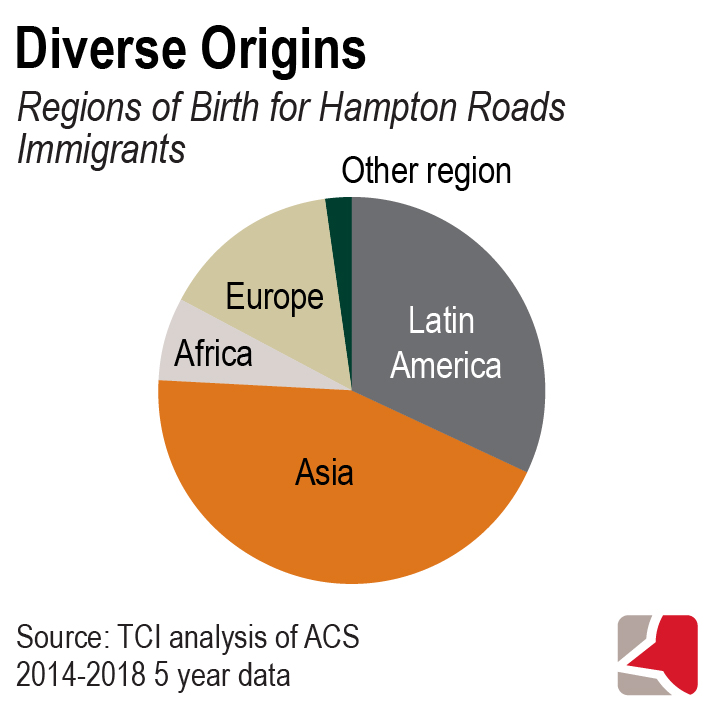
In the Hampton Roads region, there are about 106,682 immigrants. Foreign-born Virginians make up 7% of the region’s residents — less than the rate of the state’s foreign-born population (13%) and the national average of 14%. Seen another way, about 1 in 10 of all foreign-born Virginians live in Hampton Roads. And about 40% of immigrants in the region reside in Virginia Beach.
Hampton Roads’ immigrant residents come from a variety of places. Almost 8 in 10 immigrants in the area were born in Asia or Latin America, with most being from Asia. The Philippines is the most common country of birth among area immigrants, accounting for 21% of all foreign-born residents. Following the Philippines, Mexico, Vietnam, El Salvador, and Jamaica make up the top five places of origin. Other common countries of birth are India, China (excluding Taiwan and Hong Kong), Honduras, and Korea.
The race and ethnicity of immigrants is also diverse. Almost 8 in 10 immigrants in the region are people of color. More specifically, almost half (42%) of foreign-born area residents self-report their race and ethnicity as non-Hispanic Asian or Pacific Islander, and around 23% self-report as Hispanic and any race. Around 1 in 10 immigrants self-report as Black, and 2 in 10 identify as white (21%).
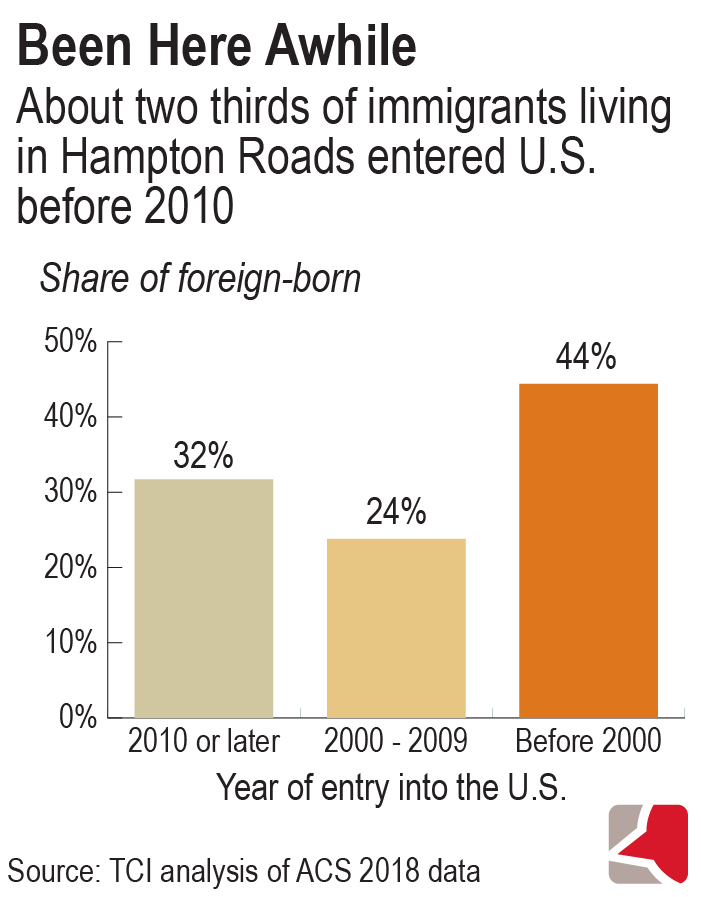
Over half (55%) of foreign-born residents of Hampton Roads are naturalized citizens, slightly higher than the statewide and nationwide rates. This means that they have completed a lengthy process including several years of residence and passing a test on U.S. history, laws, and customs, among other requirements. And most area immigrants are not newcomers: over a quarter have resided in the area since before 1990, and around 40% entered the United States between 1990 and 2009.
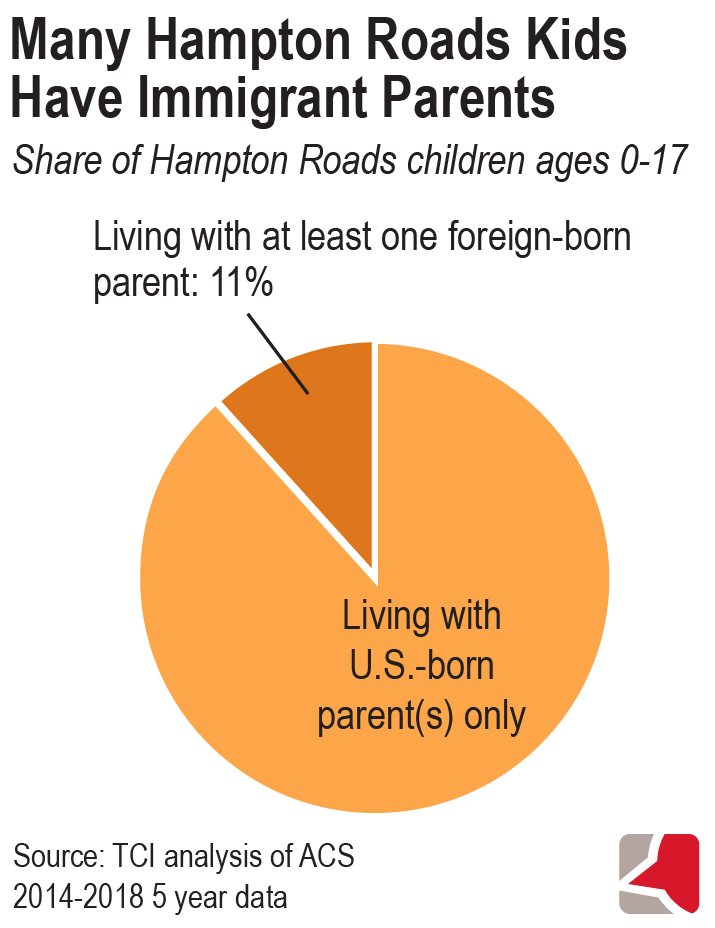
Many people continue to choose Virginia as their new home, with nearly one-third of immigrant residents moving to the area after 2010. And while there are few foreign-born children in Hampton Roads, many native-born children have parents who were born outside of the U.S. About 11% of children in the area have at least one foreign-born parent, demonstrating that many Virginia immigrants put down roots, build families, and are raising tomorrow’s community leaders and innovators.
Hampton Roads immigrants work in a variety of occupations & support the labor force
Immigrants play a large role in Virginia’s labor force and economy. Area immigrants are primarily working age (age 20 through 59), and this is reflected in their labor force participation. About 70% of foreign-born immigrants in the region are employed — higher than the 65% of U.S.-born area residents that are employed. And they work in a variety of occupations, including the region’s biggest employment sectors. Of those who are employed, around 1 in 5 area immigrants work in service occupations, which covers a wide variety of work from home health aides to restaurant servers, dental assistants, and more.
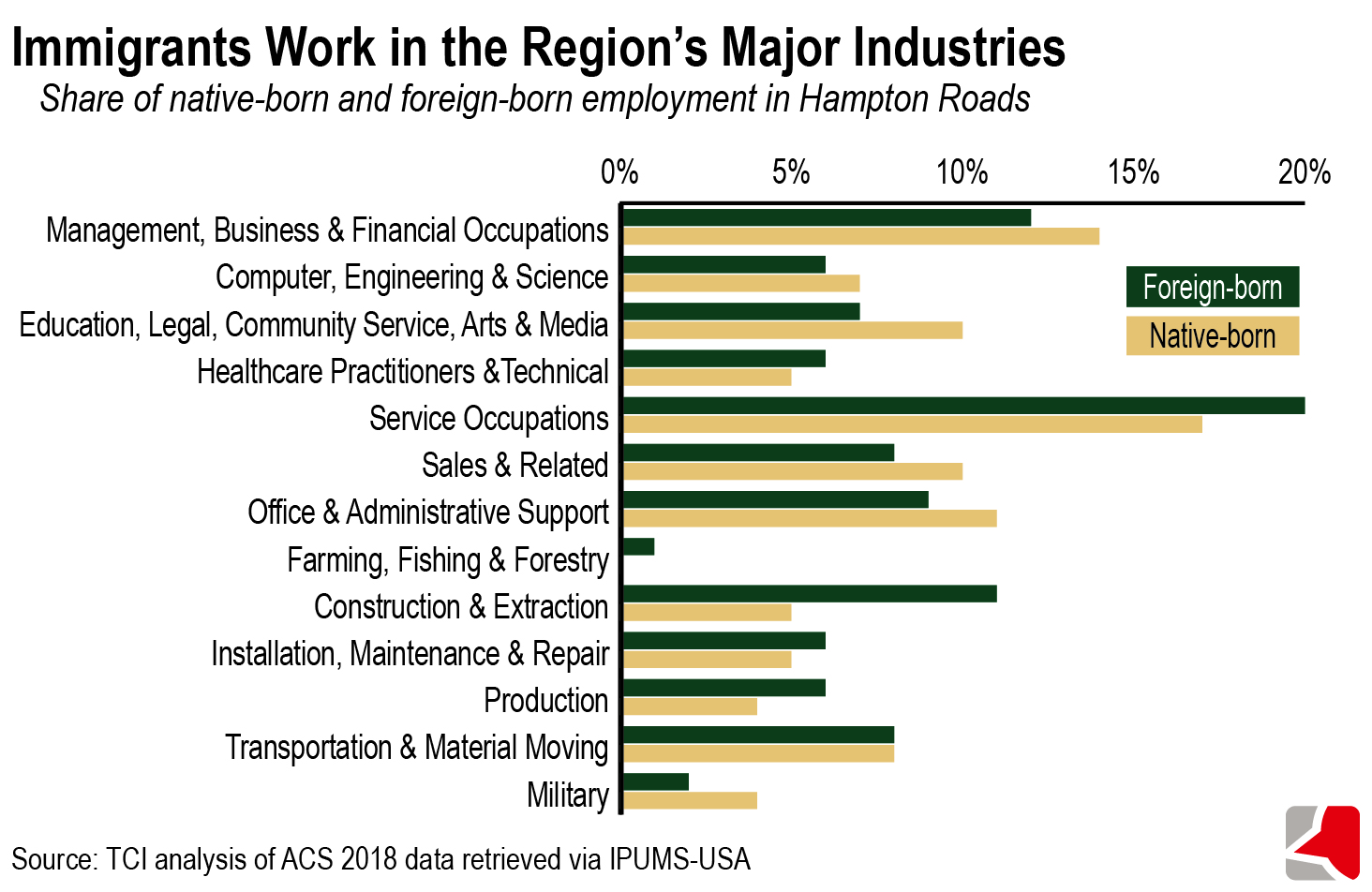
Many Hampton Roads immigrants work in “white-collar” occupations, rather than “blue-collar” occupations that typically require manual labor. About 30% of the working population works in what are considered blue-collar occupations, while 48% work in what are considered white collar occupations. Following service occupations, 12% of foreign-born immigrants work in management, business, and financial occupations. While it is the second most common sector of work that area immigrants are employed in, they are still underrepresented when compared to the native-born population. Around 14% of U.S.-born area residents make up that sector of the labor market, which tends to be highly-paid. Finally, many area immigrants work in construction (11%) and office and administrative support (9%).
While well educated, earnings lag for area immigrants of color
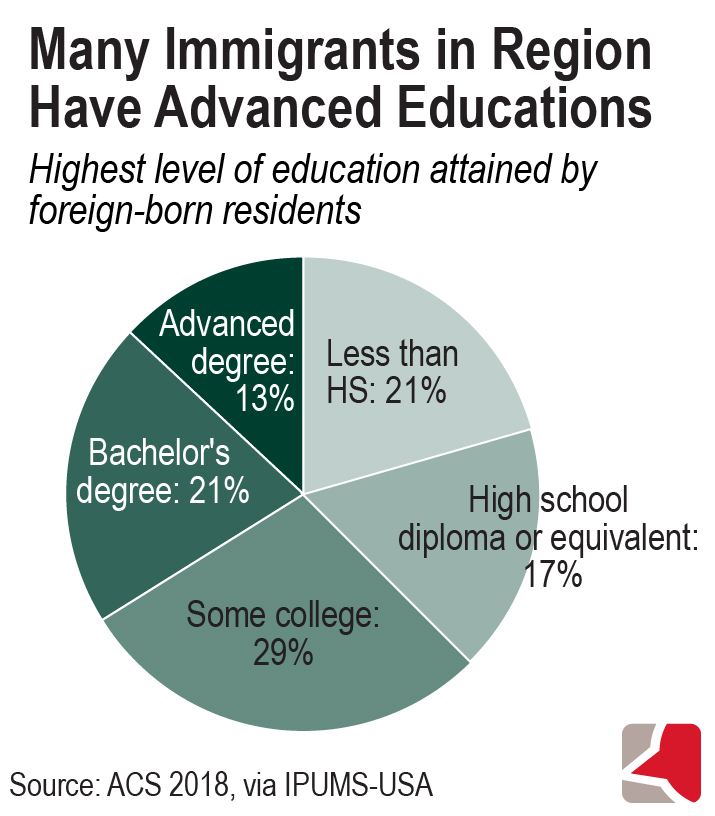
Many area immigrants are also well educated. Two-thirds of the foreign-born population in Hampton Roads have attained at least some college education or higher, and over one-third have a bachelor’s degree or a professional degree — higher rates than for the foreign-born population nationally. However, immigrant residents are far more likely to have only attained some (and not completed) high school than U.S.-born residents. This may signal that greater efforts should be made to connect students with educational services that meet their needs. Now that in-state college tuition is available regardless of citizenship status, more students who are immigrants may feel that a high school diploma offers a realistic path forward to college and be able to access more affordable higher education, which in turn will increase the education levels of Virginia’s workforce.
Most immigrants in the region also speak English fluently. More than half speak only English, speak English “very well”, or “well”, which has likely enabled their success in education and the labor force. However, many are still learning — more than 1 in 10 immigrants in the region speak English at levels lower than “well”, and it is important to recognize their needs.
With most immigrants in the region being well educated and participating in the labor force at a greater level, median household incomes for immigrants in Hampton Roads ($64,500) are about the same as those of U.S.-born residents in the region ($65,600). However, these incomes differ when data is broken out by race. While the median household income for white, non-Hispanic immigrants reaches to around $73,000, incomes are much lower for immigrants of color. Median household income for area immigrants who are non-Hispanic Asian American or Pacific Islander is lower at $72,300. Median income for immigrants who are Latinx and any race ($40,000) is over a third lower than U.S born residents in the region. These incomes may present challenges for some immigrants of color to meet the cost of living in Hampton Roads.
Policy options at the state level can help address barriers to housing and health
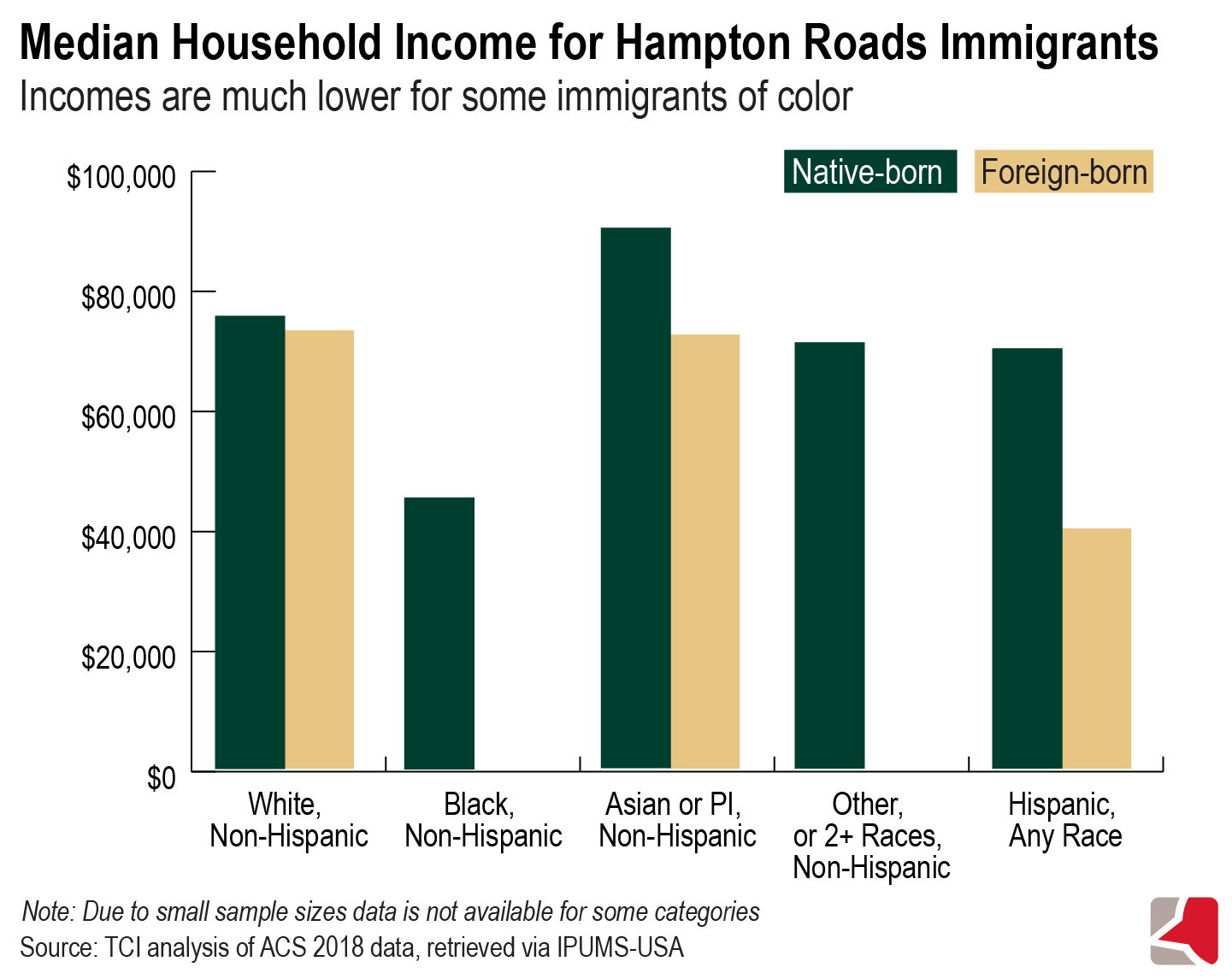
Housing costs a burden particularly for immigrant households
Housing costs in the region are one of the major challenges for all area residents, and particularly for immigrant families. Around 28% of all foreign-born area residents pay more than 30% of their income towards housing costs, a share that the U.S. Department of Housing and Urban Development defines as a cost burden. Looking at U.S.-born area residents, around the same share pay more than 30% of their incomes towards housing costs. Affordable housing is a challenge for many in the area.
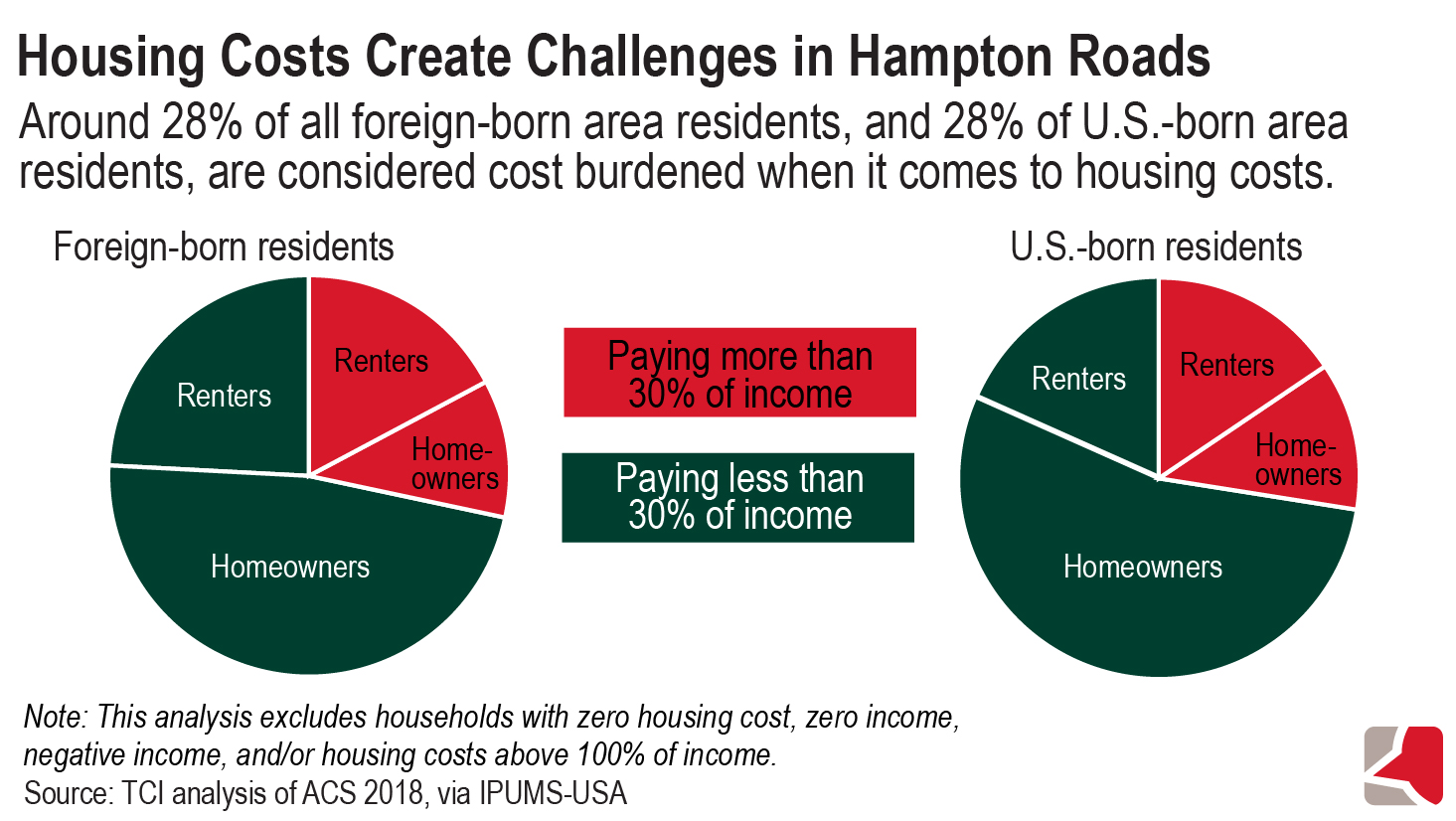
Policymakers can take immediate and long-term steps to address housing challenges
There are a number of policy options that would alleviate some of this housing cost burden. In the short term, and more specifically during the upcoming special session, legislators should restore the funding increases made toward housing-related programs, which were temporarily suspended in response to the economic crises brought upon by the COVID-19 pandemic. This includes the Housing Trust Fund, which provides low-cost loans for affordable rental and homeownership opportunities, eviction defense/diversion and affordable housing pilot programs, and increases in permanent supportive housing. In addition to reenacting these new funds, lawmakers should make continued and increased investments in the Housing Trust Fund and related housing programs in order to make sure that basic needs are met for more people in Virginia.
Reducing barriers to new construction of high-density, affordable, and mixed-income housing could also lower housing costs for both immigrant-born and U.S.-born households. Inclusionary zoning and zoning reform policies — the latter of which was proposed in the most recent legislative session — seek to require developers to sell or rent a portion of a residential housing development to people who have lower incomes and allow duplexes in areas zoned for only single-family homes in order to make affordable housing easier to build. These policies, alongside enforcement and strengthening nondiscrimination statutes, will help make sure families are not turned away from a home because of their race, nationality, or immigration status and would help alleviate housing challenges in the Hampton Roads region.
Lack of health coverage a concern, particularly for non-citizens
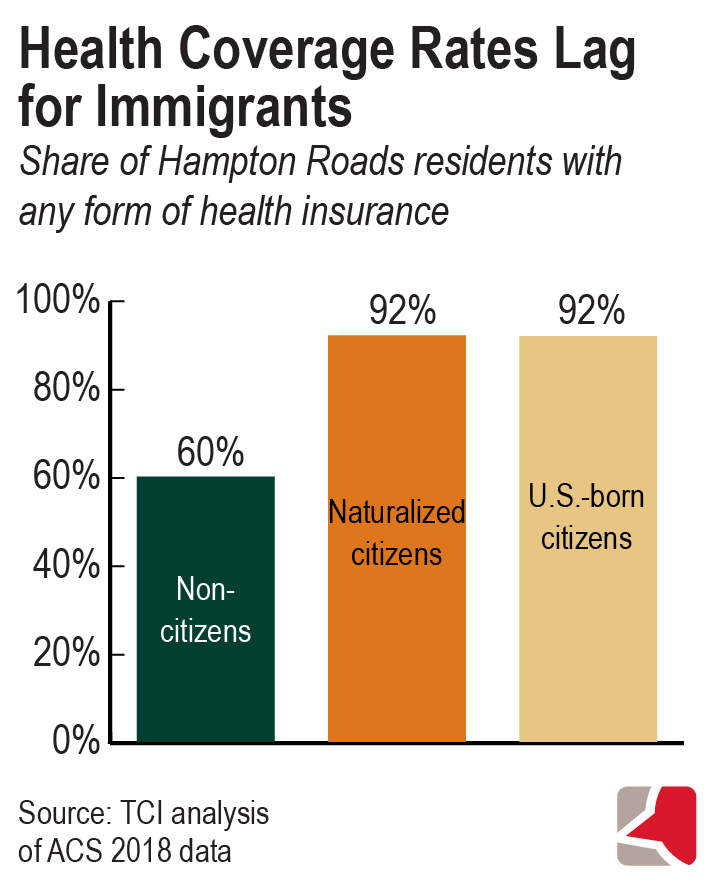
Access to health care coverage is another challenge for some in the region. While 92% of U.S.-born area residents are insured, only 78% of all foreign-born area residents have health insurance. This trend is more pronounced for area immigrants that are non-citizens, who have even lower rates of health coverage than the naturalized foreign-born population. More than half as many non-citizens have public health coverage compared to U.S.-born area residents. And nearly 4 in 10 — 18,759 area residents — of all non-citizens in the region have no health coverage at all.
Lawmakers can remove barriers, make intentional choices to support communities
The number of uninsured non-citizens has increased since 2014, showing that coverage gaps remain. Access to affordable health care coverage in the area was a challenge well before the COVID-19 pandemic, and it may be just one reason why COVID-19 is impacting residents who are Latinx and/or Black at higher rates. Policymakers should make sure that funding to eliminate barriers, such as the “40 quarter” rule, is fully restored during the upcoming
special legislative session in order to address some of the health care access challenges. And additional, intentional health care policy choices should be made that would support immigrants and people of color during this especially challenging moment and beyond.
Hampton Roads’ residents who are immigrants — and immigrants all across the state — are key members of our communities and contributors to our economy. As mostly long-time residents of the region, they have put down roots and have often found success. However, addressing challenges faced by many in the immigrant community in Hampton Roads — such as lower incomes, lack of health insurance, and language barriers — is critical to ensure the well-being of our communities and to build a Virginia that works for all of us.
Methodology Note
These reports define the “U.S.-born” population as those who were U.S. citizens at birth, including those born in any of the 50 states, the District of Columbia, Guam, Puerto Rico, and the U.S. Virgin Islands, and those born to U.S. citizens abroad. The term “foreign-born” and “immigrants” are used interchangeably within these reports to refer to those who were born abroad and were not U.S. citizens at birth.

